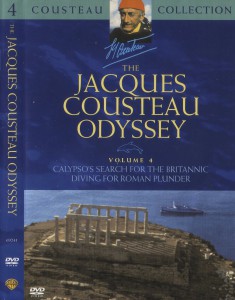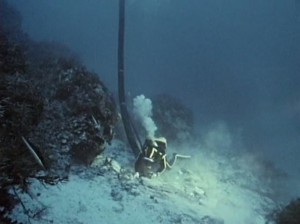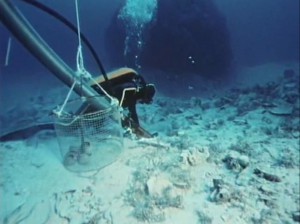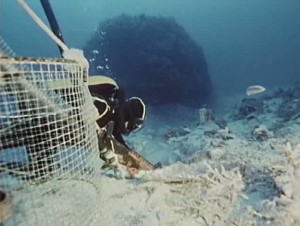In 1976, the government of the Hellenic Republic invited Captain Cousteau to come to Greece and dive at several sites. The purpose was to produce a series of television shows showcasing the beauty and history of Greece. These dives at Dia, Antikythera, Delos, and eslewhere became episodes in the 1970s series, The Cousteau Odyssey. The Antikythera episode was titled, “Diving for Roman Plunder.”
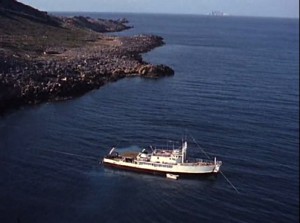
On site at Antikythera, Cousteau moored CALYPSO over site in a web of lines running to shore and to anchors set around the wreck. The ship had to be safely secured, as the divers and Greek colleagues descended to the wreck with a dredge connected to a pump aboard CALYPSO. If the ship moved, it would drag the dredge hose and the divers away from the work site.
Working with the dredge in 10-minute dives, CALYPSO’s team and their Greek colleagues sucked away sediments to expose artifacts. In 27 days and despite frequent bad weather, they recovered hundreds of objects: ceramic vessels, components of marble statues, bronze statuettes, bronze coins, gold jewelry and gemstones, fine glassware, and human skeletal remains.
While preparing for the 2014 expedition, our team had the pleasaure and honor of meeting Lefteris Tsavliris, who participated in the 1976 program. He kindly shared pictures and text recounting some of his experiences, posted here:
—
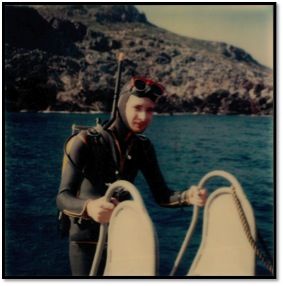
My name is Lefteris Tsavliris, I am a surveyor engineer and Managing Director of AKTI ENGINEERING which is involved with Marine and Land Surveying Services. In 1976, I was 22 years old and student of the surveying department of the National Technical University of Athens.
Having a big love with everything that is related with research and the sea, during my Diploma Thesis I made contact with very important archeologists such as George Papathanasopoulos who was the pioneer of the Marine Archeology in Greece. At that time, the only organization involved with the Marine Archeology was the Greek Institute of Marine Archaeology and other friends of Marine Archaeology from Greece and from abroad. I have been member of this institute since 1974.
In 1976, Jacques Yves Cousteau agreed with the Greek Government to make a movie production regarding the Greek Marine Archeological treasures. The Greek Ministry of Culture asked from the Greek Institute of Marine Archeology to support the supervision of the Cousteau operation by sending some of its divers – members. The Greek Institute of Marine Archeology supported the supervision of the operations with its members, the amateur divers Vasilis Vitalis, John Garas, and Petros Nikolaidis.Thanks to the experience I had gained participating in similar expeditions between 1974 and 1976, I was invited to take part in the new operation as well. I accepted without hesitation as the dream of any diver was to work close to the holy monster of marine research, Jacques Yves Cousteau.
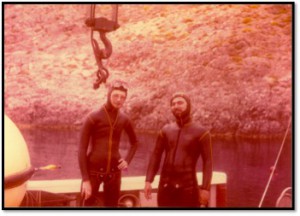
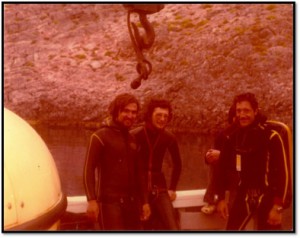
The divers Lefteris Tsavliris and Vasilis Vitalis on board “Calypso”, joined by Calypso diver Raymond Cole.
So, in June of 1976, my colleague Vasilis Vitalis and I were found on board “Calypso”, the Cousteau research vessel, above the famous Antikythera shipwreck, ready to start working for a supplementary excavation to the first one which had been carried out in 1900 and 1901.
Our job was to work for the excavation with the Cousteau divers and to help the authorized Marine Archeology representative for the operation, Mr Lazaros Kolonas, to supervise the research. The operations were completed in November of 1976, after some pause due to bad weather conditions.
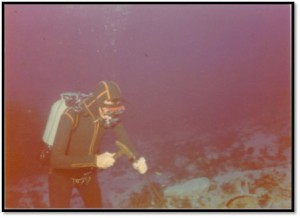
Diver Lefteris Tsavliris working for the recovery of the bronze statuettes. (Water depth 54m)
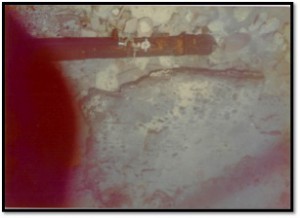
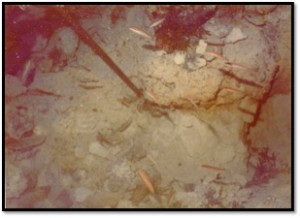
The head of the air lift and the iron rod for the rock breaking for the release of the bronze statuettes.
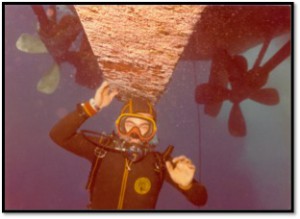
The divers Lefteris Tsavliris and Vasilis Vitalis in decompression under “Calypso” keel.
—
The 2014 team offers it sincere thanks to Lefteris Tsavliris for his generosity.
